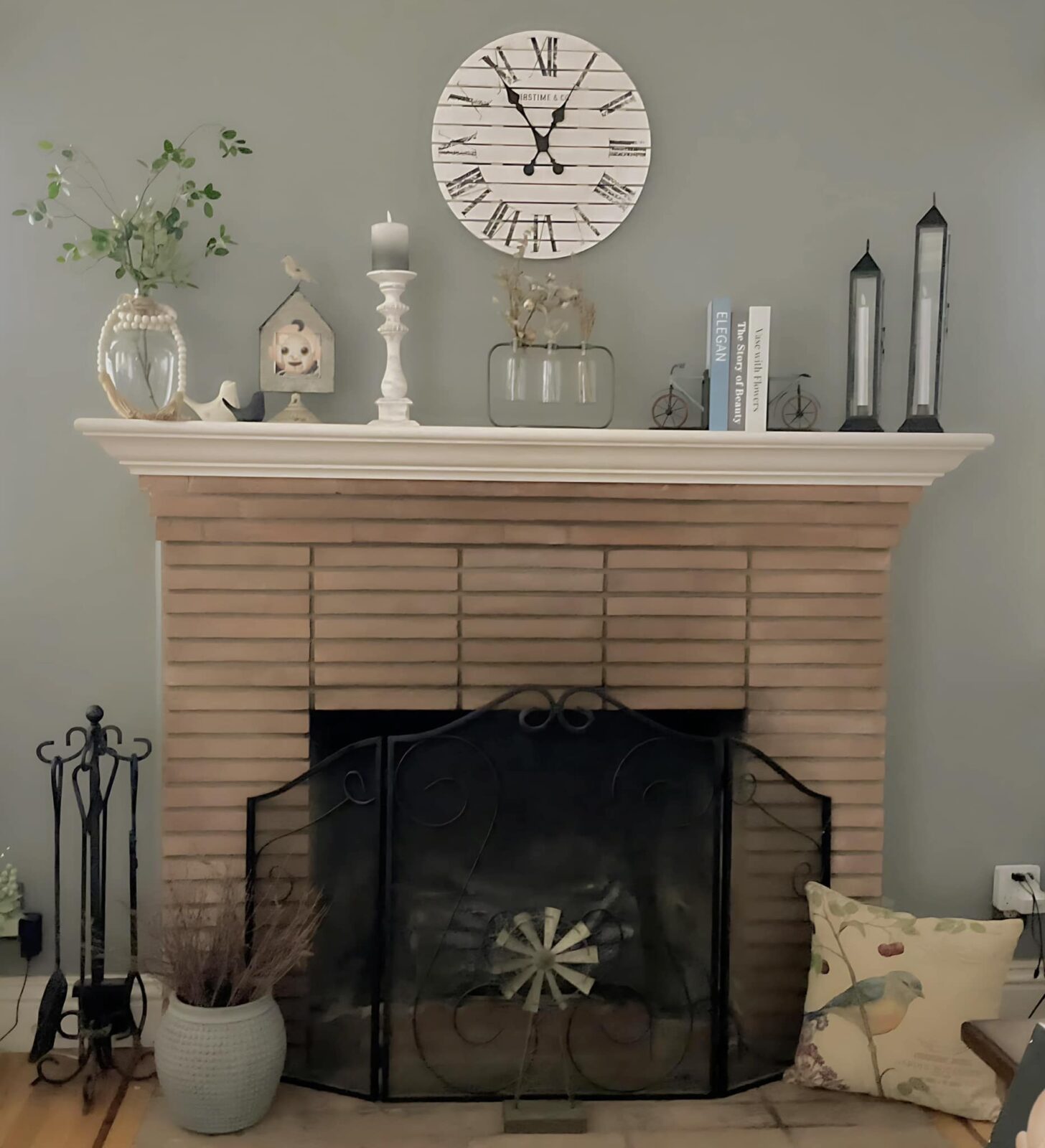A well-built and maintained fireplace will serve you for many years but won’t last forever. At some point, you’ll need to repair, update, and ultimately replace the entire fireplace. You could be considering replacing your fireplace but aren’t entirely sure it’s time.
So, how can you know for sure? We’ve got you covered. This guide digs deep into the telltale signs indicating it’s time to replace your fireplace.
Let’s get to it.
Telltale Signs It’s Time For A New Fireplace
The following factors indicate that you need a new fireplace.
1. The Fireplace Is Old
How long have you had your fireplace? Fireplaces have varied lifespans, with some lasting longer than others. For instance, a properly maintained prefab wood-burning fireplace lasts 10 to 30 years, while a masonry fireplace can last as long as your house.
On the other hand, expect an electric fireplace to serve you for 10 to 20 years, depending on its quality, use, and maintenance, and 10 to 15 years for a gas fireplace.
Start thinking about replacing your fireplace if it has surpassed its lifespan.
2. Extensive Damages
You can repair minor fireplace damages, such as a cracked door, and have your fireplace working efficiently again, but the same can’t be said about extensive damages. Replacing your fireplace may be safer and more economical if it develops extensive structural damage.
Watch out for these damages:
a) Cracked Firebox
Over time, the firebox can develop cracks due to prolonged exposure to heat from the fire. A cracked firebox will let smoke, heat, and even flames escape, putting the surrounding areas at risk of fires. In addition, it may allow carbon monoxide into the house.
b) Damaged Mortar Joints
The mortar holding the bricks and stones together will eventually deteriorate, particularly due to the absorption of excess moisture, temperature fluctuations, and high heat. Damaged mortar joints will cause your fireplace to develop cracks, especially at the joints or corners.
c) Loose Bricks or Stones
Inspect your fireplace for loose bricks or stones because they can compromise its integrity. Moreover, if loose stones or bricks, especially from the chimney, fall, they can damage the roof or injure someone.
You can repoint or replace a few loose bricks or stones. On the other hand, replacing the whole fireplace may be necessary if more and more bricks or stones keep coming loose.
d) Spalling Bricks
Spalling occurs when bricks soak up water, causing them to crumble, flake, or chip off. If you fail to fix this issue, the bricks can suffer complete failure, thus compromising your fireplace’s structural integrity.
e) Rust on Metal Parts
Rust compromises the functionality of metallic parts. For instance, a rusted damper may get stuck, fail to open and close properly, and negatively impact heat control and airflow. Also, rust can make the flue liner to break.
f) Damaged Chimney Crown
The chimney crown protects your fireplace from elements like rain and snow. If this component gets damaged, water will seep through, potentially leading to corrosion on the metallic parts. Water also absorbs the limestone and salts in the bricks, weakening your fireplace.
Water will also infiltrate your fireplace through cracks in the chimney.
Related Posts:
- How to Stop a Fireplace Draft
- Brick Fireplace Ideas For Living Room
- How to Get Rid of Fireplace Smell
- Signs Chimney or Fireplace Needs Cleaning
3. The Fireplace Doesn’t Heat Your Home As It Used To
The primary purpose of a fireplace place is to provide heat, so if yours no longer gives adequate heat, you might want to consider getting a new one. But first, what causes a fireplace to become less heat efficient?
- Damages in components like the damper, firebox, fireplace doors, and bricks will let heat escape. These parts can also prevent the fireplace from producing heat consistently.
- Your fireplace will have difficulty keeping your home warm if it lets in cold air.
- The chimney makes wood-burning fireplaces lose a lot of heat.
The energy bills will increase if your fireplace doesn’t produce sufficient heat. This warrants replacing it with an energy-efficient model.
4. Drafts
Installation flaws and structural issues in your fireplace can make the room drafty. For instance, damaged dampers or seals and a leaky chimney can lead to drafts. You can solve this problem by replacing your current fireplace with a new, well-installed one.
5. Maintenance and Repairs Start Stacking Up
How frequently have you had to call a fireplace expert to fix issues like sealing chimney cracks and ignition problems in your fireplace? You may have performed some DIY repairs on it yourself.
When your fireplace starts requiring repair and maintenance work more regularly, replacing the whole unit could be a better solution. This is because frequent upkeep is inconvenient, costly, and time-consuming.
You are also better off getting a new fireplace if you uncover consistent issues during annual inspections.
Read More:
6. Excessive Creosote Buildup
A wood-burning fireplace produces some creosote, so it should not be a cause for alarm. However, an excessive buildup is a problem since it indicates your fireplace doesn’t burn efficiently.
Instead of dealing with constant creosote removal, why not replace your current fireplace with a gas, electric, or more efficient wood-burning fireplace?
7. Excessive Soot Production
Like too much creosote buildup, excess soot production indicates poor combustion. You will also find yourself cleaning your fireplace more often if it produces a lot of soot. Fortunately, modern electric, gas, and pellet fireplaces burn cleaner and produce less soot.
8. Your Fireplace Produces The Smell of Sulfur
If you smell sulfur (a foul stench similar to rotten eggs) when you turn on your gas fireplace, turn it off immediately and contact a technician as soon as possible. This smell almost certainly signifies a gas leak.
A professional will be able to fix the problem or uncover a more systematic issue that could require you to replace your fireplace.
9. Ignition Problems
These issues affect gas and electric fireplaces. For instance, if the pilot light frequently goes out, your gas fireplace likely has a faulty gas valve, malfunctioning thermocouple, or clogged pilot tube. Re-evaluate the unit if you constantly have to relight the pilot light— you may need to replace the whole unit.
You may need to consider upgrading your electric fireplace with a newer, better model if it frequently develops electrical problems with the heating elements, wiring, and switches.
10. Outdated Aesthetics
If your fireplace no longer aligns with your home’s design and style, you may want to replace it with a more aesthetically appealing model. As design trends for homes are ever-evolving, the styles that were once stylish might be outdated now.
Your style may also evolve over the years. For example, if you now prefer a contemporary style but have a traditional fireplace, upgrade it to a modern model.
Note
Perhaps your new home came with a fireplace that isn’t to your taste. In this case, consider changing it to the one you want.
11. For Sustainability
Making your home more eco-conscious is a compelling reason to replace your outdated fireplace with an environmentally friendly, more efficient model. Unlike traditional fireplaces, modern models are equipped with advanced technology to produce optimum heat without using less fuel.
Replacing a wood-burning fireplace with an electric or gas unit will also help lower your carbon footprint because they emit less carbon dioxide. Also, consider switching to a fireplace that uses renewable energy instead of wood.
Moreover, if you wish to make the air inside your home safer and cleaner, replace an old wood-burning fireplace, especially a poor-functioning one, with a modern gas and electric unit.
12. White, Chalky Stains
Is your brick, concrete, or stone fireplace covered with a white, chalky residue? This indicates excess moisture in the masonry. You can remove this substance through cleaning, but this only addresses cosmetic issues.
This issue calls for major repairs— it may be easier to replace the whole fireplace.
Other Reasons To Replace Your Fireplace
Aside from the issues above, you should replace your fireplace for the following reasons.
a) Getting Ready To Sell Your Home
You can make your home more marketable and even get a higher price if you upgrade the fireplace. A stunning, eye-catching fireplace can leave a strong impression on potential buyers.
b) Enhanced Safety
Modern fireplaces are equipped with safety features, so upgrading your old fireplace with a newer one can make your home safer. For instance, some models have carbon monoxide detectors that will notify you in the case of unsafe levels.
Conclusion
Replacing your fireplace will effectively fix the issues discussed above, making your fireplace more efficient, safer, and aesthetically pleasing. Choosing to replace the fireplace instead of constantly repairing parts that break down will ultimately save you money.

Hi! I’m Susie, the creative mind behind Cozy Castle 101. I love sharing easy and simple ideas to make home and garden spaces cozy and inviting. From simple DIY projects and fun crafts to family-friendly recipes, I’m all about creating a warm, welcoming home where memories are made. Join me as I explore ways to add a bit of creativity and charm to everyday life!

